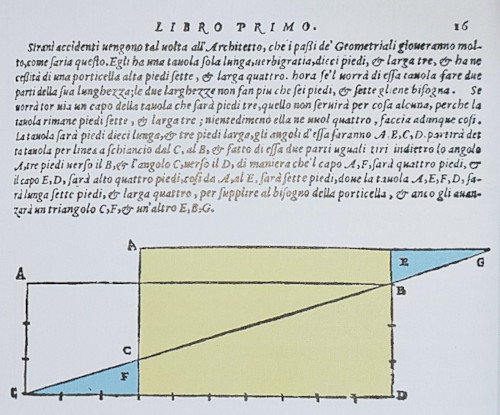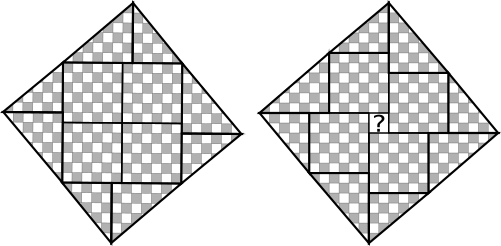Organize the five pieces to form a €50 ticket. You have to choose faces in reddish colors.
He then rotates the pieces so that the faces are visible in greenish colors and builds a €100 bill.
Where is the missing little rectangle?
- Hotel Area: Sala Martin Gardner
- Minimum age: from 6 years old.
- Required time: 5 minutes.
- Number of participants: One or more people
- Paraules clau: Descomposició de figures, pendent, inclinació
- Taxonomy: Geometry

The explanation
Obviously NOT, there must be some explanation, the total surface of the pieces is the same on both sides.
In some of these disappearance paradoxes what happens is that the final outer perimeter is slightly larger, in others the explanation is that the pieces do not fit perfectly. What is the explanation in this case?
The lower side of the triangle has a slope of 5 vertical units for 12 horizontal units (see the grid in the animated image) therefore 5/12=0.4167 vertical units for each horizontal unit.
And the two pieces that fit together do not have the same slope. One has slope of 2/5=0.4 and the other of 3/7=0.4286.
This creates a small surface space equivalent to the missing rectangle

Un recorregut històric de les paradoxes de desaparicions geomètriques
The first known record of these puzzles appears in the book "Lbro Primo di Architettura" by Sebastiano Serlio (1475-1554) a Renaissance architect.
In the text of the image, Serlio explains how to transform the ABCD rectangle of 3×10=30 units into two rectangles, the yellow of 4×7=28 and the one formed by the two blue triangles of 1×3=3.

Martin Gardner he dedicates a chapter of his 1955 book Mathematics Magic and Mystery to geometric disappearances. As always, his explanations are very understandable. You can read it here in Spanish (PDF).

The Quirinus Puzzle
This geometric disappearance version from 2012 is the work of Gianni Sarcone and Marie-Jo Waeber they call it Puzzle Quirinus, you can download the PDF to print it, play with it and of course, look for an explanation.

